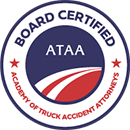What Dangers Does a Trucker with Sleep Apnea Pose to Other Drivers?
In the bustling world of transportation, truck drivers play a pivotal role in keeping goods moving across our nation.
However, there’s a silent threat that can compromise the safety of our roads – sleep apnea.
Accidents resulting from driver fatigue number more than 100,000 per year in the US alone. These accidents cause 71,000 injuries and 800 preventable deaths on average and cost up to $20 billion annually, with an average cost per accident of $91,000.
When a trucker with sleep apnea is behind the wheel, the likelihood of contributing to these alarming statistics becomes significantly higher.
What Is Sleep Apnea?
This common sleep disorder affects many truckers, posing serious risks to both their well-being and the safety of fellow drivers. In this blog post, we’ll delve into the dangers associated with truckers having sleep apnea, exploring its implications and shedding light on local statistics.
Sleep apnea is a condition characterized by pauses in breathing during sleep, leading to disrupted and poor-quality sleep. It’s not just a health concern for truckers; it’s a potential hazard for everyone sharing the road.
Comorbidities
Conditions such as hypertension, diabetes, and cardiovascular disease are more prevalent among individuals with untreated sleep apnea. These comorbidities can exacerbate the overall health of truckers, further compromising their fitness for duty.
Treatment for Sleep Apnea
The treatment of sleep apnea is essential for improving the quality of sleep for affected individuals as well as for addressing the potential dangers associated with the condition. Treatment options for sleep apnea can vary based on the severity of the condition, its underlying causes, and individual health factors.
Common and effective treatment options include:
- Continuous Positive Airway Pressure (CPAP): CPAP involves wearing a mask over the nose or mouth during sleep, which is connected to a machine that delivers a continuous flow of air. This airflow helps keep the airways open, preventing pauses in breathing.
- Bi-level Positive Airway Pressure (BiPAP): Similar to CPAP, BiPAP also delivers air pressure but adjusts the pressure levels based on the individual’s breathing patterns. It provides a higher pressure during inhalation and a lower pressure during exhalation.
- Adaptive Servo-Ventilation (ASV): ASV is a more advanced form of positive airway pressure therapy that continually monitors breathing and adjusts air pressure to stabilize breathing patterns.
- Surgery: Surgical options may be considered in cases where other treatments have not been successful. Surgical procedures may involve removing excess tissue from the throat, repairing structural abnormalities, or implanting devices to support airway function.
Lifestyle changes can significantly impact sleep apnea as well. These may include weight loss, avoiding alcohol and sedatives, positional therapy (changing sleeping position), and quitting smoking.
Sleep Apnea and Driving
One of the primary dangers lies in the impact on a trucker’s alertness and reaction time. Untreated sleep apnea can result in excessive daytime sleepiness, making it difficult for truck drivers to stay focused on the road.
The first and most immediate danger stems from the impaired cognitive function caused by sleep apnea.
When truckers are fatigued due to disrupted sleep patterns, their ability to concentrate, make decisions, and react quickly to unexpected situations is compromised.
Imagine the potential consequences when a large commercial vehicle weighing tens of thousands of pounds is operated by a driver experiencing diminished cognitive function. It’s a recipe for disaster on the road.
To mitigate these risks, trucking companies must implement comprehensive screening processes for sleep apnea among their drivers.
Regular sleep assessments and screenings can identify those at risk, enabling early intervention and treatment. Additionally, education on the importance of quality sleep hygiene and encouraging lifestyle changes can play a pivotal role in preventing sleep apnea-related accidents.
Beyond the immediate dangers posed by impaired cognitive function and the risk of drowsy driving, sleep apnea also increases the likelihood of other health issues that can affect a trucker’s ability to operate a vehicle safely.
From a regulatory perspective, there is an increasing recognition of the importance of addressing sleep apnea in the trucking industry.
The Federal Motor Carrier Safety Administration (FMCSA) has implemented guidelines and recommendations for the screening and treatment of sleep apnea among commercial drivers. Compliance with these regulations is essential not only for the safety of truckers but also for the well-being of everyone on the road.
Local initiatives and partnerships between health organizations and the trucking industry can play a vital role in tackling the issue of sleep apnea. Collaborative efforts to raise awareness, provide accessible screening programs, and offer support for treatment can contribute to a safer driving environment for everyone.
The dangers that a trucker with sleep apnea poses to other drivers are multifaceted. From impaired cognitive function to an increased risk of head- on accidents or others typically caused by drowsy driving, the consequences are significant.
It’s not just a matter of individual health but a collective responsibility to ensure the safety of our roads.
Through proactive screening, education, and regulatory compliance, we can pave the way for a safer and more secure transportation landscape for everyone. Get in touch with our law office, Trucking Injury Law Group, to schedule a free consultation with an attorney who can advise you of your rights in your case.






